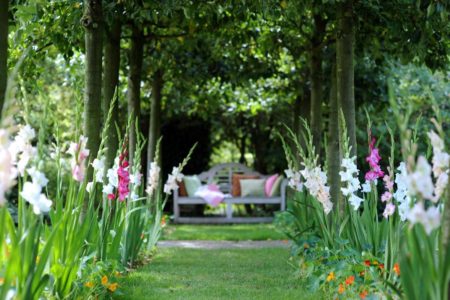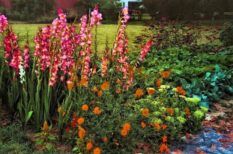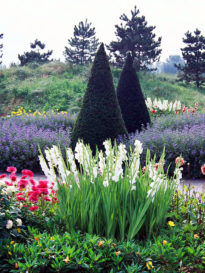Gladioli are striking in their beauty and variety. These flowers, with proper care, will be a spectacular end to the garden season, blooming in flower beds almost at the beginning of September. The key to exuberant flowering of gladioli is planting and care in the open ground according to the rules.
Material Content:
When and how to plant gladiolus in open ground?
It is important for the florist to know not only how to plant gladioli, but also when, since the timing of planting bulbs is of great importance for the quality of laying flower-bearing arrows.
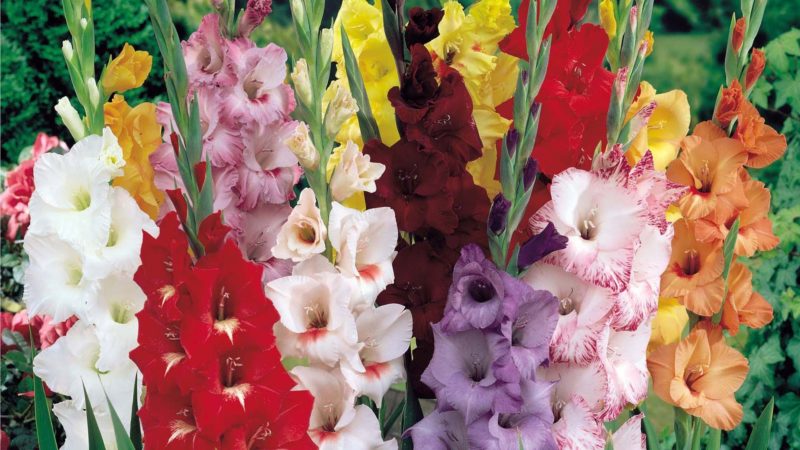
Growing gladioli requires compliance with agricultural technology!
Regarding the timing of planting, opinions differ somewhat. Someone thinks that gladioli should be planted depending on the heating of the soil, and someone - according to climatic conditions. However, if abnormally warm temperatures occur, then when orienting on heating the soil, you can plant flowers too early, and when the cold returns, the bulbs will suffer, which will negatively affect flowering.
There are general recommendations for planting gladioli in open ground, which is desirable to focus on, but naturally with some adjustment regarding the weather, which may turn out to be too cold, and then the landing will move. In the southern regions of Russia, under normal weather conditions, the optimal time for planting material landing is from mid-March to mid-April. In the middle lane, landing should be carried out in late April - early May. In the Urals and Siberia, landing is carried out from May 5 to 15.If at the recommended planting time the soil temperature at a depth of 12 cm does not reach +10 degrees, gardening work will need to be postponed.
How to prepare for landing?
Planting material and flowerbed must be prepared in high quality. Gladioli cannot simply be planted in newly excavated earth.
Soil requirements
The soil for gladioli needs nutritious and quite loose. For this, she is prepared for planting flowers in the fall. If the soil is loamy, sand is added to it, and if it is too sandy, then compost. When the soil is too acidic, to reduce this indicator it is required to use chalk or dolomite flour, which are used at the rate of 200 g per 1 m2.
Digging in the autumn is the main. It is carried out at 1 depth of the bayonet of the shovel, and after that nutrient soil and fertilizers are introduced.

Soil enrichment per 1 m / sq should be as follows:
- humus or peat compost - 1 bucket of 10 l;
- superphosphate - 3 matchboxes;
- potassium salt - 1.5 matchboxes;
- wood ash - 1 can with a volume of 500 ml.
After fertilizing, the flower bed is re-dug. In the spring it only needs to be loosened up, and again it is not necessary to dig up.
If it was not possible to prepare a place for planting in the fall season, all preparatory work in the spring should be carried out in the same order 2 weeks before planting the material.
Bulb preparation before planting
Bulbs before planting require special preparation, without which beautiful flowers cannot be obtained. Preparation of plants begins 30 days before they are planted in the ground.
After removing the planting material from the basement or refrigerator, it is cleaned of dry scales, which, if left on the bulb, will delay its germination. Early varieties may already begin to produce sprouts, and therefore, when cleaning, care must be taken not to break them.
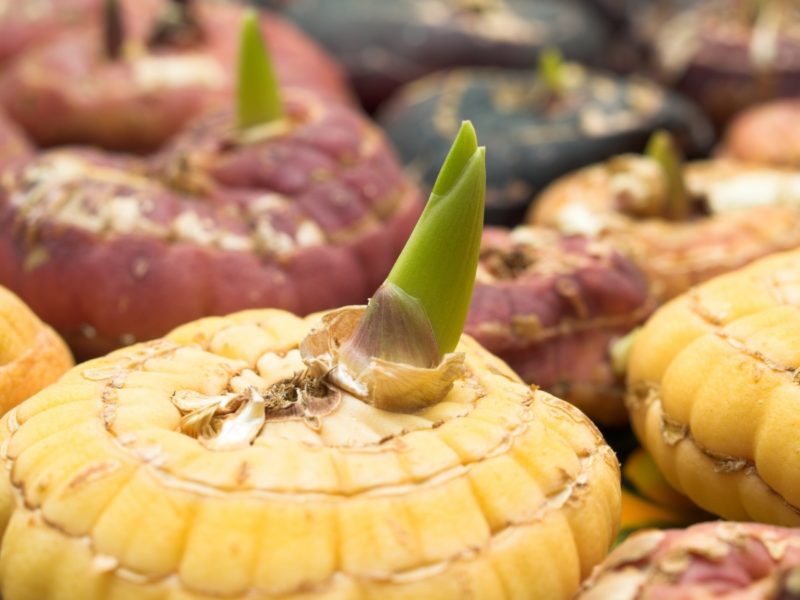
Sick bulbs are rejected, because they can not get beautiful flowers from them, but they can infect the rest of the material very easily. If the spoiled place is small, it can be cut with a knife, which is previously heated over a fire, and immediately gloss over with brilliant green. This will save the bulb.
After this, the gladiolus is placed for germination in a bright, warm place with low humidity. Bulbs should give a strong, not high sprout and not long root buds.
If the bulbs do not sprout, planting them is useless
Immediately before planting, gladioli are treated with an antiseptic solution. Without this, the bulbs will most likely get sick.
For processing apply:
- Maxim preparation - according to the instructions;
- foundationazole - in a solution with a strength of 0.3%, planting material is aged 30 minutes;
- Manganese - in a solution with a strength of 0.3%, the bulbs can withstand 2 hours.
Positive effect on plant growth and treatment with growth stimulants (according to the instructions for them).
Choosing a place to land
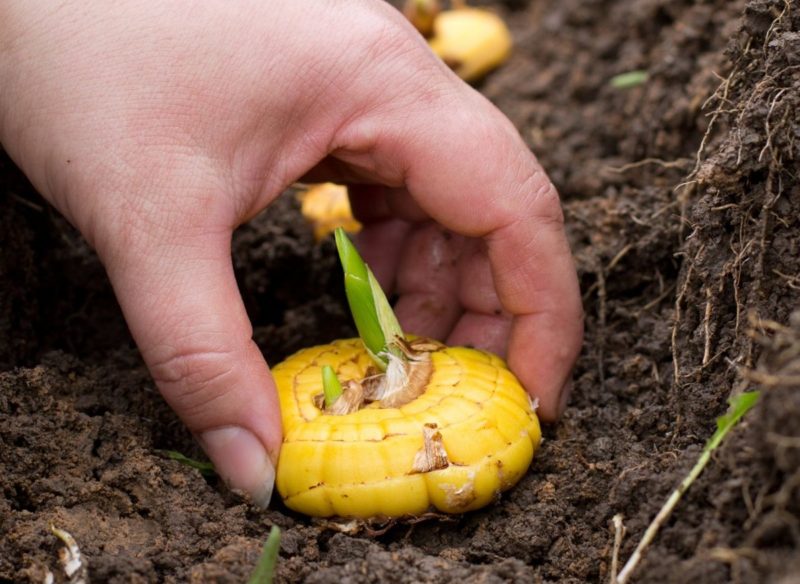
The flowerbed with gladioli is located exclusively in well-lit areas, inaccessible to wind and with light drained nutrient soil. Also, the planting site should not be bothersome. Optimally, if at noon, when the sun's rays are especially burning, the plants will shade slightly, as this will allow them not to spend energy on protection from excessive ultraviolet radiation, and flower-bearing arrows will be better.
Outdoor grass care
Proper care of gladioli allows you to get the highest quality flowering. Without care, even excellent bulbs will not give good flowering arrows.
Watering, fertilizing and fertilizing
Flowers love water, and when irrigated per 1 m2, 15 liters are required. The soil should be properly moistened to a depth of 35 cm, since the roots of the bulbs reach it. Water the flowerbed as necessary. In order to better absorb water, it is good to make shallow grooves.
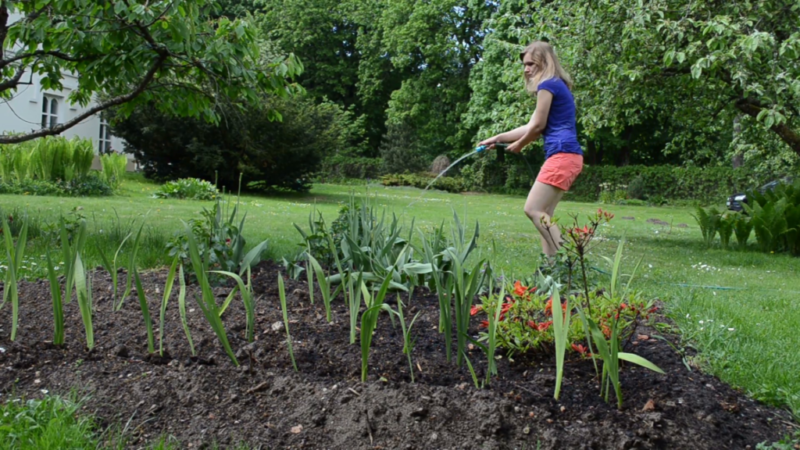
Gladioli are fed 4 times during the whole season. The first top dressing is needed when sprouts from the ground appear and they reach a height of 10 cm. For this, ammonium nitrate is used, which is 3 tablespoons in volume.soluble in 10 l of water. The solution is poured ¼ cup under each flower.
The second top dressing is carried out when 4 sheets appear. At this point, potash fertilizer is used (similar to nitrogen).
The third top dressing occurs at the time of bud formation. For top dressing, special formulations for gladioli are used (according to the instructions for them).
The fourth top dressing with a solution of superphosphate (40g / 10l) is carried out at the end of flowering. More fertilize the plant is not required.
Proper weeding
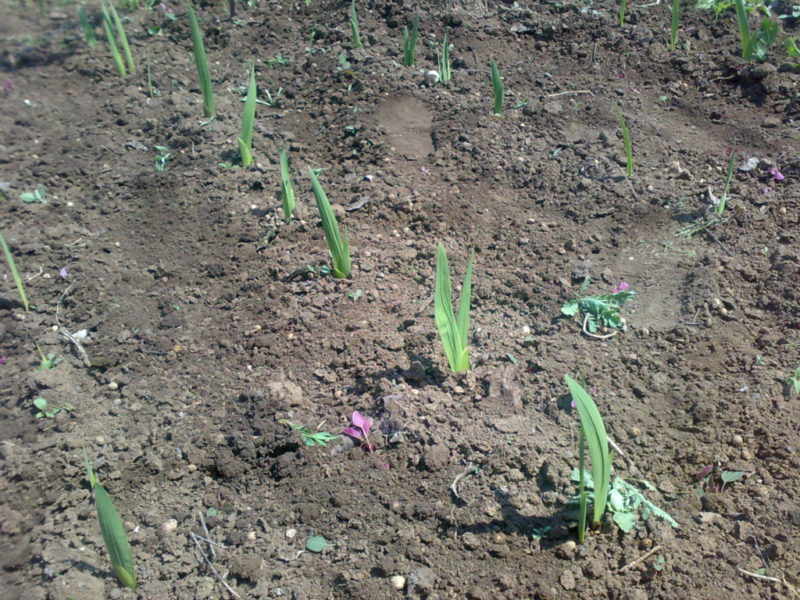
Weeding is needed, because when weeds appear, plant growth slows down significantly. Work is carried out as necessary. Weed removal is required with the root.
When and how to cut gladiolus flowers?
Cut flowers early in the morning or late in the evening when they are not exposed to heat and sun. If long transportation of flowers is required, they are cut off in a phase when one or at most 2 buds is open. The arrows will fully open already in the water during transportation.
For the full development of the bulbs, cutting should be carried out taking into account the need to leave a high-quality aerial part. At least 4 leaves are left on the plant.
When to dig plants?
After flowering, the bulbs should ripen in the soil for another 1-1.5 months. Bulb maturity can be determined by the brown color of its outer scales and the easy passage of the children. Digging should be carried out before the onset of frost.
Weather on the day of digging plants should be dry. The first varieties are dug up first. The remains of the aerial parts and roots are cut off completely. From the ground, the bulbs are washed with running water.
Bulb storage of gladiolus
Storage of gladioli must be organized correctly. Bulbs must be kept for 30 minutes in the "Maxim" to destroy pathogenic bacteria. After the material is sorted by size and dried.
Next, the bulbs are placed in ventilated boxes, which are covered with newspapers, and left to mature at a temperature of +30 degrees for 2 weeks. Then, for another month, the bulbs are kept at +22 degrees.
Then it is cleaned. To do this, with the help of scissors with a blunt end, the old bulb is separated. Scales are not removed from the bulbs. Children are separated from the parent bulb and immediately stored in paper bags in a cool, dry place. Adult bulbs are kept for 2 days after cleaning at +20 degrees and then also in paper bags are stored in a dry basement or refrigerator.
Gladioli in landscape design
In landscape design, gladioli are not often used, since they require a lot of care. Also against the gladioli says that they are very fond of pests. Also in landscaping, the short flowering period that these herbaceous plants have is also called a minus.
When planting a garden, gladioli should be planted in separate groups. They should not be planted next to rare and valuable crops, as they can be infected by diseases or parasites from the flower.
It is good to use gladiolus for planting in a cache-pot, which helps to prevent infection of other plants through the soil, and also to place flowers where there is no place for an ordinary flowerbed. Such a cultivation of these flowers today is considered optimal.
Gladioli at the time of flowering amaze with the variety of their colors and shapes and allow you to create unusual flower beds on which plants of different varieties are combined.


